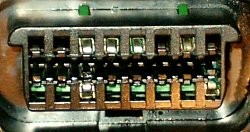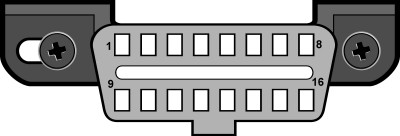Understanding whether your vehicle is OBD2 compliant is crucial for modern car diagnostics and maintenance. OBD2, or On-Board Diagnostics II, is a standardized system that allows you to access your vehicle’s health information using a scan tool. But how do you know if your car supports this system? This guide, created by the experts at carparteu.com, will help you determine your vehicle’s OBD2 compatibility and what it means for you.
It’s important to note that OBD-II compliance is determined by where your vehicle was originally sold, not where it was manufactured. So, regardless of where your car was made, the regulations of the country where it was first sold as new are what matter for OBD-II compatibility.
For hybrid and electric vehicles, which are designed for low or zero emissions, compatibility with standard OBD-II scan tools can be limited or non-existent. Always consult your vehicle manual or dealership to confirm OBD-II support for these types of vehicles.
Decoding OBD-II Compatibility by Country and Model Year
The easiest way to check for OBD-II compliance is by referring to the regulations of the country where your vehicle was initially sold. Below is a comprehensive chart outlining OBD-II implementation timelines across various regions. Find the country of your vehicle’s original sale to determine the model year requirements for OBD-II compliance.
| Country of Sale | Model Years | Notes |
|---|---|---|
| United States | 1996 | All cars and light trucks model year 1996 and newer are OBD-II compliant. |
| European Union (Diesel) | Full OBD-II Compliance for 2007 and onward | Limited Compliance from 2004-06 |
| European Union (Petrol) | Full OBD-II Compliance for 2002 and onward | Limited Compliance from 2001 |
| Canada | 1998 | |
| Algeria | 2014 | |
| Argentina (Domestic) | 2008 | |
| Argentina (Imports) | 2009 | |
| Australia (Diesel) | 2007 | |
| Australia (Petrol) | 2006 | |
| Bahrain | Full OBD-II Compliance for 2018 and onward | Limited Compliance from 2017-18 |
| Brazil (Petrol) | Full OBD-II Compliance for 2007 and onward | Limited Compliance from 2005-06 |
| Brazil (Diesel) | Full OBD-II Compliance for 2015 and onward | Limited Compliance from 2013-14 |
| Chile (Diesel) | 2013 | |
| Chile (Petrol) | 2014 | |
| China (Beijing – Petrol) | 2008 | |
| China (Country – Diesel) | 2011 | |
| China (Country – Petrol) | 2010 | |
| Costa Rica | Limited Compliance from 2017 onward | |
| Hong Kong | 2006 | |
| India | Full OBD-II Compliance for 2017 and onward | Limited Compliance from 2013-16 |
| Iran | 2012 | |
| Israel | 2003 | |
| Japan | Full OBD-II Compliance for 2008 and onward | Limited Compliance from 2003-07 |
| Kuwait | Full OBD-II Compliance for 2018 and onward | Limited Compliance from 2017-18 |
| Mexico | 2007 | |
| Morocco | 2010 | |
| New Zealand (Diesel) | 2007 | |
| New Zealand (Petrol) | 2006 | |
| Nigeria | 2015 | |
| Oman | Full OBD-II compliance for 2018 and onward | Limited Compliance from 2017-18 |
| Peru | 2003 | |
| Peru | 2017 | |
| Philippines | 2016 | |
| Qatar | Full OBD-II Compliance for 2018 and onward | Limited Compliance from 2017-18 |
| Russia | Full OBD-II Compliance for 2012 and onward | Limited Compliance from 2010-11 |
| Saudi Arabia | Full OBD-II Compliance for 2018 and onward | Limited Compliance from 2017-18 |
| Singapore | 2014 | |
| South Korea | Full OBD-II Compliance for 2010 and onward | Limited Compliance from 2005-09 |
| Taiwan | 2008 | |
| Thailand | 2013 | |
| Turkey | 2013 | |
| United Arab Emirates | Full OBD-II Compliance for 2018 and onward | Limited Compliance from 2017-18 |
| Vietnam | 2017 | |
| Yemen | Full OBD-II Compliance for 2018 and onward | Limited Compliance from 2017-18 |


OBD-II Compliance in the United States: Model Year 1996 and Newer
In the United States, the Environmental Protection Agency (EPA) mandated OBD-II compliance for all cars and light trucks starting from the 1996 model year. This landmark legislation ensures standardized emission monitoring and diagnostics across a wide range of vehicles. You can find more detailed information on the EPA’s official website. If your vehicle was sold new in the US and is a 1996 model year or newer, it is almost certainly OBD-II compliant. This includes a vast array of makes and models, such as those listed below:
| Acura | Alfa Romeo | Ariel Atom | Aston Martin | Audi | Bentley | BMW | Buick | Cadillac | Chevrolet | Chrysler | Citroen | Daewoo |
|---|---|---|---|---|---|---|---|---|---|---|---|---|
| Daihatsu | Daimler | Dodge | Ferrari | Fiat | Ford | Geo | GMC | Holden | Honda | Hummer | Hyundai | Infiniti |
| Isuzu | Jaguar | Jeep | Kia | Lamborghini | Lancia | Land Rover | Lexus | Lincoln | Lotus | Maserati | Mazda | McLaren |
| Mercedes | Mercury | MG | Mini | Mitsubishi | Nissan | Oldsmobile | Opel | Pagani | Panoz | Peugeot | Plymouth | Pontiac |
| Porsche | Regal | Renault | Rolls-Royce | Roush | Rover | Saab | Saleen | Saturn | Scion | Shelby | Skoda | Smart |
| Subaru | Suzuki | Tesla | Toyota | Triumph | TVR | Vauxhall | Volkswagen | Volvo | Yugo |
European Union OBD-II Standards: Petrol (2001+) and Diesel (2004+)
The European Union implemented OBD-II (known as EOBD) in phases, with different timelines for petrol and diesel vehicles.
For petrol vehicles sold in the EU, full OBD-II compliance was mandatory for all new types from January 1, 2000, and for all types from January 1, 2001, as per Commission Directive 70/220/EEC, Annex I. This directive applies to category M1 vehicles (passenger vehicles with no more than eight seats in addition to the driver’s seat and a maximum mass not exceeding 2500 kg) and category N1 class I vehicles (light commercial vehicles with a maximum mass not exceeding 2500 kg).
For diesel vehicles in the EU, OBD-II compliance became mandatory from January 1, 2003, for new types and from January 1, 2004, for all types, again according to Commission Directive 70/220/EEC, Annex I. This applies to category M1 vehicles, excluding those designed to carry more than six occupants including the driver and vehicles with a maximum mass exceeding 2500 kg, from 1 January 2003 for new types and from 1 January 2004 for all types. Keep in mind that “European Union” in these directives refers to the member states at the time of implementation (2000 and 2003).
Identifying OBD-II Compliance for Other Vehicles
If your vehicle doesn’t fall into the US or EU categories, there are other ways to check for OBD-II compliance. Look under the hood of your car for a Vehicle Emission Control Information label. This label often explicitly states whether the vehicle is designed to comply with OBD-II regulations.
Fig. 1 – Example of a Vehicle Emission Control Information Label indicating OBD-II compliance.
In the context of these labels, “OBD-II” is often used as a broad term encompassing various global OBD standards, including:
- OBD II (California Air Resources Board – ARB standard)
- EOBD (European On-Board Diagnostics)
- JOBD (Japanese On-Board Diagnostics)
Consulting your vehicle’s owner’s manual or contacting your local dealership can also provide information. However, be aware that not all dealers are fully informed about the nuances of OBD vs. OBD-II standards.
If your vehicle is confirmed to be non-OBD-II compliant, standard OBD-II scan tools like ElmScan will not be compatible for retrieving diagnostic data.
The 16-Pin OBD Connector: Not a Guarantee of OBD-II Compliance
Many people mistakenly believe that the presence of a 16-pin Diagnostic Link Connector (DLC) in their vehicle automatically means it’s OBD-II compliant. This is not always the case. Several European and Asian manufacturers began using the 16-pin connector shape long before fully adopting OBD-II systems.
Interestingly, vehicles that are not EOBD compliant often have a DLC that doesn’t completely adhere to the SAE J1979 standard, which outlines the physical characteristics of the OBD-II connector. As an example, compare the following images. Notice the “ears” present on the non-EOBD compliant Ford Escort DLC, which are absent in the standard J1962 OBD-II connector. This subtle difference can sometimes be a visual clue.
Fig. 2 – Diagnostic Link Connector (DLC) from a non-EOBD compliant Ford Escort (Image courtesy of DigitalFriction, UK).
Fig. 3 – Standard J1962 Vehicle Connector, Type A, as used in OBD-II compliant vehicles.
In conclusion, determining if your vehicle is OBD2 compliant requires checking the country of sale, model year, and potentially the vehicle emission control information label. While a 16-pin connector is often present in OBD-II vehicles, it’s not a definitive indicator of compatibility. By using this guide, you can confidently ascertain whether your vehicle supports OBD-II diagnostics and ensure you’re using the right tools for vehicle maintenance and repair.